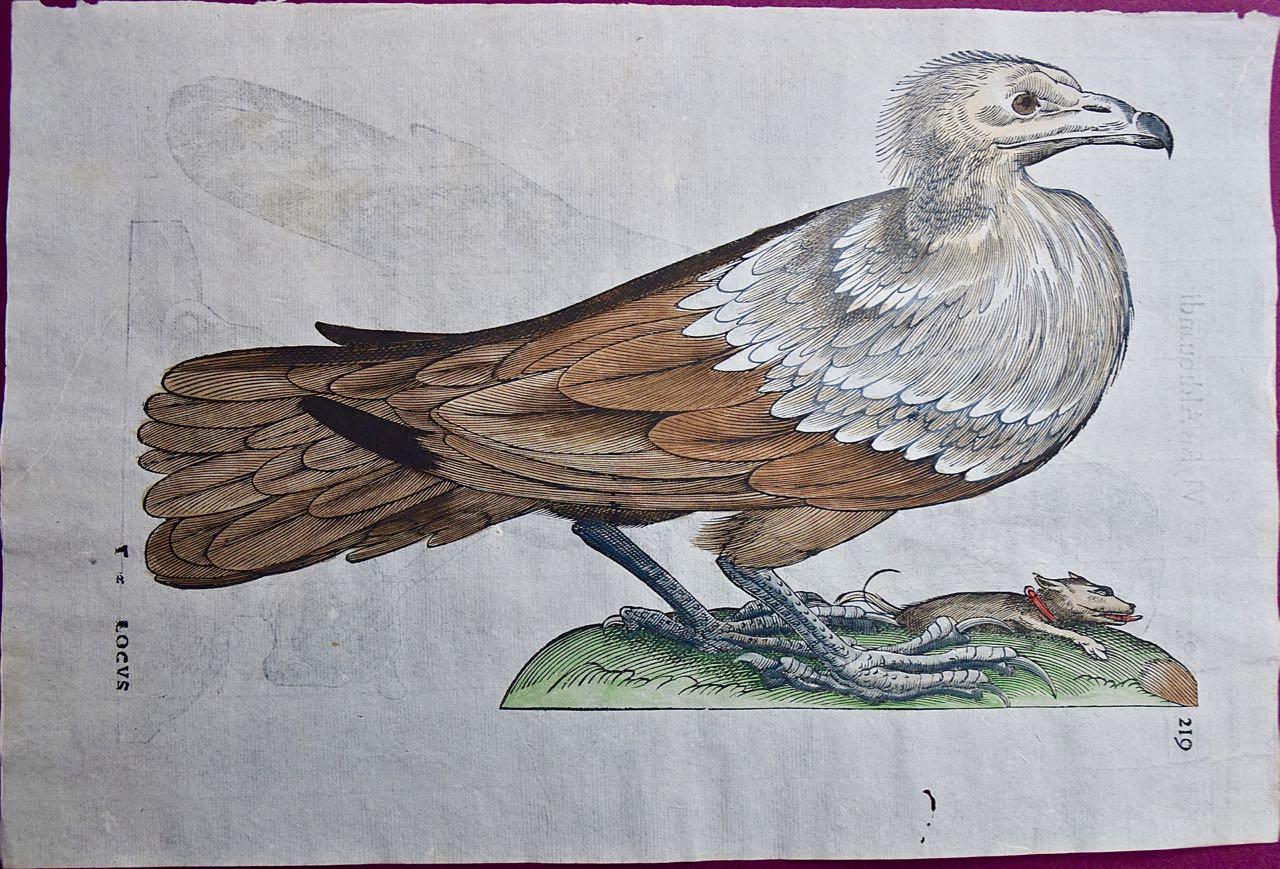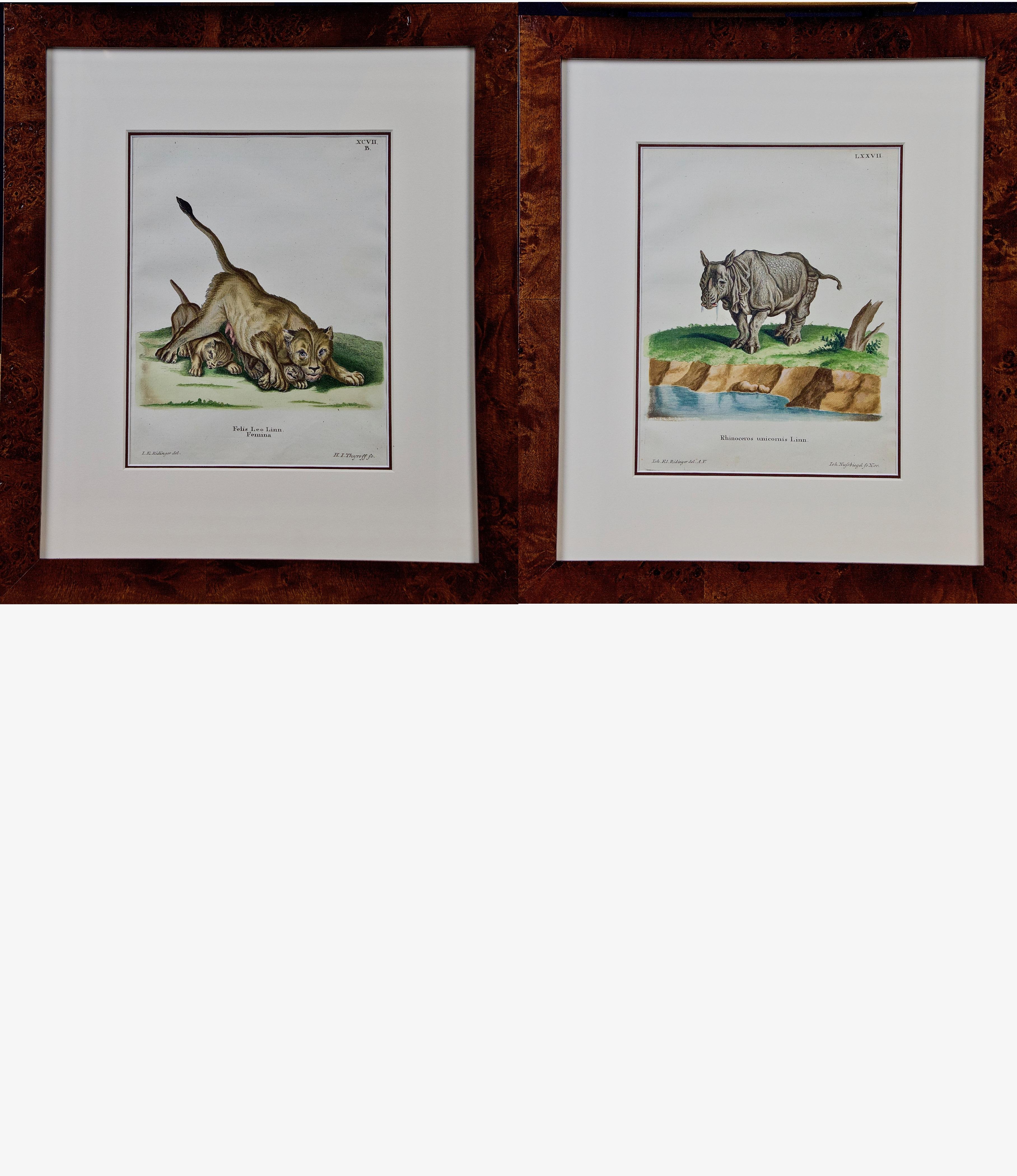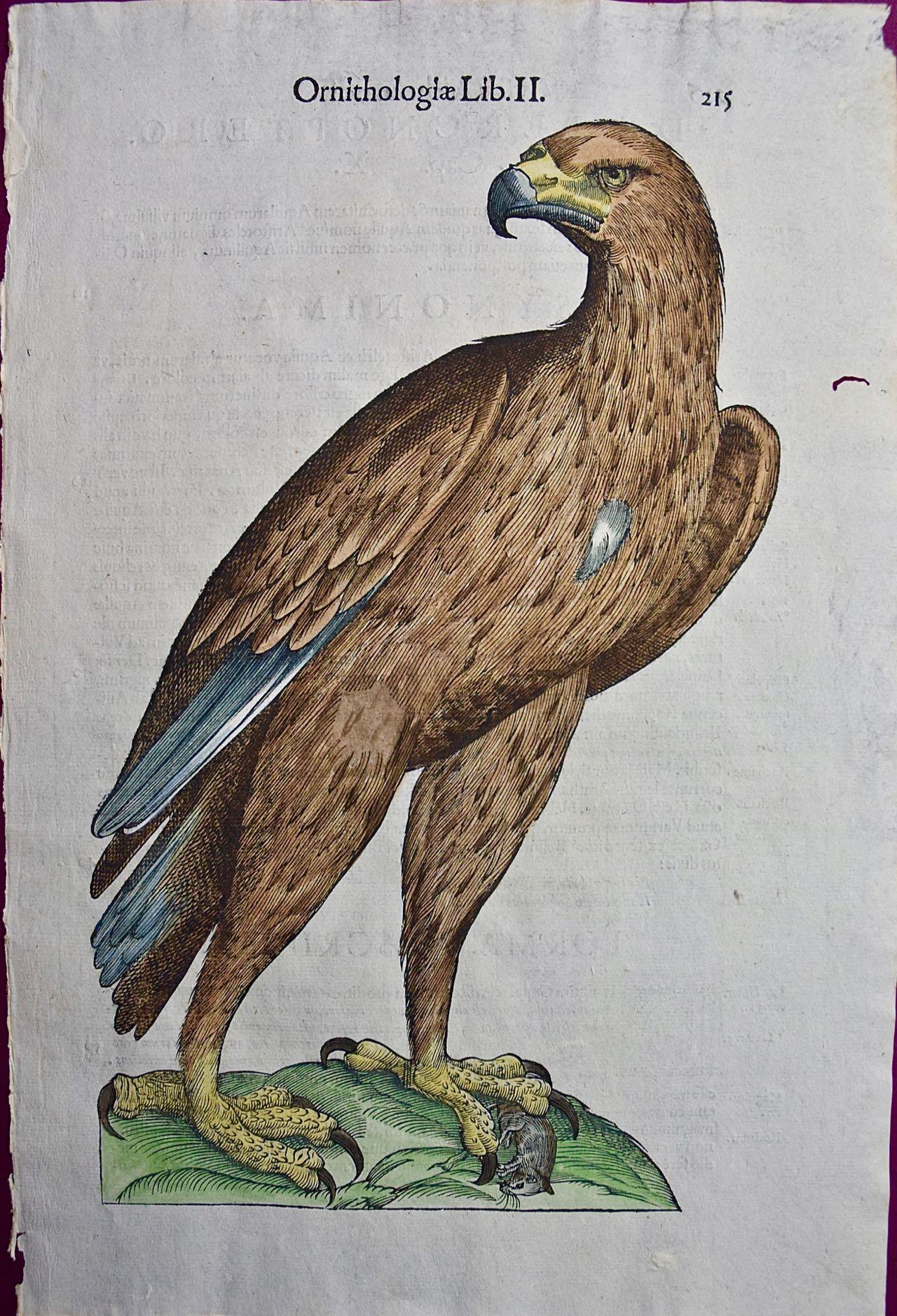Items Similar to Swainson's Warbler: A Framed Original Hand-colored Audubon Folio Bird Engraving
Want more images or videos?
Request additional images or videos from the seller
1 of 11
John James AudubonSwainson's Warbler: A Framed Original Hand-colored Audubon Folio Bird Engraving 1828
1828
About the Item
This is an original John James Audubon hand-colored folio sized lithograph entitled "Swainson's Warbler, Male, Sylvicola Swainsonia, Tree: Vulgo, White Oak", No. 10, Plate 50, from Audubon's "Birds of America". It was engraved, printed and hand colored in London by Robert Havell, Jr. in 1828. It depicts a male Swainson's Warbler bird perched on a branch of a white oak tree, amid large leaves and acorns. Audubon later stated: "This little bird was by mistake engraved, and named after my friend W. Swainson, Esq., during my absence from London, one drawing having been accidentally substituted for another. It is in reality the young of the Black and Yellow Warbler, and was intended to form part of the Plate which will represent the adult male and female of that species.” William Swainson (1789-1855) was the first ornithological illustrator to use lithography, which Audubon later adopted for the production of his octavo edition of the Birds of America.
This original large folio-sized hand colored Audubon bird engraving is presented in an ornate medium brown-colored wood frame with a light tan-colored mat. It is glazed with UV conservation glass and all mounting materials are archival. There are a few short wrinkles, but the print is otherwise in very good condition.
John James Audubon (1785-1851) was a naturalist and artist. He was initially unsuccessful financially prior to the publication of his famous work “The Birds of America”, spending time in debtor’s prison, once stabbing a disgruntled investor in self-defense. However, his obsession with birds and art motivated him to persist in his goal of documenting every bird in America via his watercolor paintings and publishing his works for all to enjoy. Audubon's first illustrations were published in a large elephant folio size. Due to their expense they were purchased in rather small numbers by the wealthy. To reach a larger audience, Audubon, with the help of his sons and J. T. Bowen, published a smaller octavo sized lithograph version, which were much more affordable.
With the success of his bird projects, Audubon then turned his attention to four-legged animals. He explored the Missouri River in 1843 sketching the four-legged animals he encountered in their natural setting. His expedition covered some of the same regions recently explored by Lewis and Clark, traveling from present day Alaska to Mexico. Audubon realized that this was an opportunity to document these animals in the still relatively pristine American wilderness, before man encroached on their environment.
Between 1845 and 1848, Audubon and his sons John Woodhouse Audubon and Victor Gifford Audubon produced a set of elephant folio sized lithographs that were primarily engraved and hand colored by J. T. Bowen in Philadelphia. The publication, which included text descriptions of the animals was published 3 years before Audubon died. As with the birds, this was followed by a three-volume set of 155 octavo-sized plates entitled “The Quadrupeds of North America” completed and published by Audubon’s sons, John, Jr. and Victor.
Audubon prints continue to be popular and a wise investment. The double elephant folio set “The Birds of America” have sold at auction for as much as $8.8 million, and individual plates may sell for six figures. The beautiful octavo sized plates are not as expensive, but becoming more sought after, as the folio bird plates become unattainable to all but the very wealthy.
Robert Havell Jr. (1793-1878) was the main engraver for Audubon's folio Birds of America publication. His aquatint engravings of most of the plates (except for the first ten) is considered a significant artistic achievement and was essential to the success of Audubon's Birds of America. Havell and Audubon became close friends and associates. In 1839 Havell went to America at the invitation of Audubon, first residing in Brooklyn. He settled in Ossining on the Hudson River and later moved to Tarrytown, New York, where he remained for the rest of his life. After the publication of Birds of America, Havell continued to create engravings, but became more known for his landscape and countryside paintings of the Hudson River valley. He travelled frequently in a homemade horse-drawn trailer, sketching and taking notes and translating his sketches into larger oils. He is considered an influential contributor of the Hudson River School of American painters. Havell died in 1878 and is buried in Sleepy Hollow Cemetery in Sleepy Hollow.
- Creator:John James Audubon (1785-1851, American, French)
- Creation Year:1828
- Dimensions:Height: 32.75 in (83.19 cm)Width: 26.25 in (66.68 cm)Depth: 1.13 in (2.88 cm)
- Medium:
- Movement & Style:
- Period:
- Condition:
- Gallery Location:Alamo, CA
- Reference Number:
About the Seller
5.0
Platinum Seller
These expertly vetted sellers are 1stDibs' most experienced sellers and are rated highest by our customers.
Established in 2011
1stDibs seller since 2019
233 sales on 1stDibs
Typical response time: 1 hour
- ShippingRetrieving quote...Ships From: Alamo, CA
- Return PolicyA return for this item may be initiated within 7 days of delivery.
More From This SellerView All
- Crowned Heron Bird: A 16th/17th Century Hand-colored Engraving by AldrovandiBy Ulisse AldrovandiLocated in Alamo, CAThis very rare, first edition, folio hand-colored engraving of a Crowned Heron bird is plate 362 from Ulisse Aldrovandi’s 'Opera Omnia', published be...Category
Early 17th Century Naturalistic Animal Prints
MaterialsEngraving
- Bird of Prey: A 16th/17th Century Hand-colored Engraving by AldrovandiBy Ulisse AldrovandiLocated in Alamo, CAThis very rare, first edition, folio hand-colored woodcut engraving of a bird of prey is plate 219 from Ulisse Aldrovandi’s 'Opera Omnia', published ...Category
Early 17th Century Naturalistic Animal Prints
MaterialsEngraving
- A Pair of Hand Colored Engravings of an African Lioness and her Cubs and a RhinoBy Johann Elias RidingerLocated in Alamo, CAA pair of 18th century hand colored copperplate engravings entitled "Felis Leo Linn Femina" and "Rhinoceros Unicornis Linn" from Dr. Johann Schreber's Die Saugthiere in Abbildungen n...Category
1770s Naturalistic Animal Prints
MaterialsEngraving
- Eagle: A 16th/17th Century Hand-colored Engraving by AldrovandiBy Ulisse AldrovandiLocated in Alamo, CAThis very rare, first edition, folio hand-colored engraving of an eagle is plate 215 from Ulisse Aldrovandi’s 'Opera Omnia', published between 1599 a...Category
Early 17th Century Naturalistic Animal Prints
MaterialsEngraving
- Eagle: A 16th/17th Century Hand-colored Engraving by AldrovandiBy Ulisse AldrovandiLocated in Alamo, CAThis very rare, first edition, folio hand-colored engraving of an eagle is plate K2 from Ulisse Aldrovandi’s 'Opera Omnia', published between 1599 an...Category
Early 17th Century Naturalistic Animal Prints
MaterialsEngraving
- Woodpeckers "Le Petit Pic" An 18th Century Hand-colored Engraving by MartinetBy François Nicolas MartinetLocated in Alamo, CAThis is a hand-colored engraving of male and female woodpeckers entitled "1. Le Petit Pie varie, 2. Sa Femelle" by Francois Nicolas Martinet, plate 598 from 'Histoire Naturelle des O...Category
1760s Naturalistic Animal Prints
MaterialsEngraving
You May Also Like
- His & Hers Prints, Pair of 18th Century Engravings of Male and Female TapirsBy Jacques Eustache de SeveLocated in Harkstead, GBA very attractive pair of engravings of Male and Female Tapirs. Etching / engraving on hand laid paper. Sheet size:(7,9 x 10,2 inch). Image size: (6,3 x 7,9 inch). Framed size: 15...Category
18th Century Naturalistic Animal Prints
MaterialsEngraving
- GreyhoundBy Georges-Louis Leclerc, Comte de BuffonLocated in Columbia, MOGreyhound 1773-1802 Engraving 14 x 10 inches Framed: 24 x 21 inchesCategory
1770s Naturalistic Animal Prints
MaterialsEngraving
- Stow Wengenroth, Friendly Neighbors (Birds)By Stow WengenrothLocated in New York, NYEdition of 80. Signed and numbered in pencil. Really, no one could draw on a lithographic stone like Stow Wengenroth. He drew many animals and birds...Category
Mid-20th Century Naturalistic Landscape Prints
MaterialsLithograph
- Terriers No. 2Located in Columbia, MOTerriers No. 2 1883-84 Chromolithograph 8.5 x 11 inchesCategory
1880s Naturalistic Animal Prints
MaterialsLithograph
- "Barmaid, " a Dwarf BeagleLocated in Columbia, MO"Barmaid, " a Dwarf Beagle 1887 Etching 3 x 5Category
Late 19th Century Naturalistic Animal Prints
MaterialsEtching
- "Cader, " a Deerhound of the Pure Glengarry BreedLocated in Columbia, MO"Cader," a Deerhound of the Pure Glengarry Breed 1887 Etching 3 x 5Category
Late 19th Century Naturalistic Animal Prints
MaterialsEtching
Recently Viewed
View AllMore Ways To Browse
A Frame
Antique Frames Black And White
Framed Print Hand Colored
Engraving New York
Framed Bird Prints
Birds On A Branch
Four Engravings
Little Bird
Bird Engraving
Art Print Folio
Engravings Of Birds
Dior Glasses Frames
Dior Glasses Frame
Dior Glass Frames
Engraving And Bird
Bird On A Perch
Black White Engravings
Black And White Engraving





